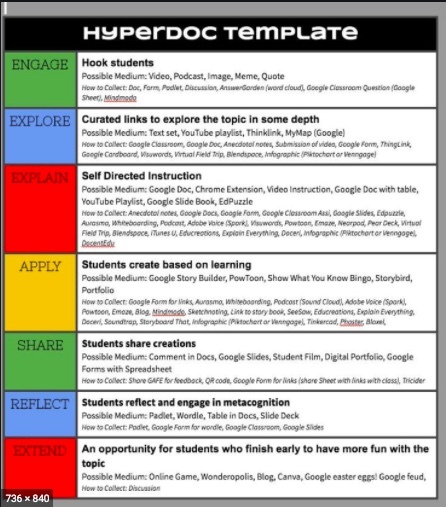New Learning MOOC’s Updates
Essential Update #7: E-Learning Technology & Pedagogy
Essential Update #7: Parse an e-learning technology or practice. To what extent and in what ways does it reflect didactic/mimetic, authentic/synthetic, or transformative/reflexive pedagogy?
Learning Management Systems, such as Google Classroom, is an example of e-learning technology. This update will show which ways this e-learning technology reflects the dimensions of transformative/reflexive pedagogy. These dimensions are Ubiquitous Learning, Active Knowledge Making, Multimodal Meaning, Recursive Feedback, Collaborative Intelligence, Metacognition, and Differentiated Learning.
This cloud-based platform moves beyond the traditional classroom and creates an environment of ubiquitous learning, which can happen anywhere, anytime, anyhow.
With the integration of Google Docs, Google Sheets, Google Slides, Gmail, and Google Calendar, the platform has three aims: To manage communication between teachers and students, simplify the process of creating and distributing class content and assignments, and grading assignments. The YouTube video you just viewed gave an overview of these features, but I would like to provide you with a few more details.
The Stream in Google Classroom does not limit the communication solely to the teacher. Students can make posts and share content, including multiple media types such as YouTube videos and Google Docs.
Assignments can be modified for different groups of students, allowing students to work collaboratively. Individuals can also collaborate with peers by sharing their work. Peers can view, edit, or comment depending on what you allow in the permissions.
Teachers create rubrics in Google Classroom for each assignment by establishing criteria, descriptions, levels, and point values. It is beneficial to teachers and students. Teachers will be able to measure growth, while students will better understand expectations within a task. Teachers are responsible for grading assignments based on the rubrics. At this time, Google Classroom does not offer the option of peer-graded assignments.
Customized learning paths within a larger group are possible in Google Classroom with the use of Google Forms. Teachers can add a quiz, from one question to multiple, with customized feedback within an assignment to help validate the learners' understanding of the work. A teacher may offer a hint and allow them to answer the question again or provide additional information in a different format. You can also enable students to skip an activity if they answer a pre-assessment question correctly.
Lisa Highfill, Kelly Hilton, and Sarah Landis developed HyperDocs and wrote the book "The HyperDoc Handbook: Digital Lesson Design Using Google Apps" 2016. The content in this section is based on the ideas presented in their book and the companion website, https://www.hyperdocs.co/start
Teachers can design digital lessons using HyperDocs: a transformative, interactive Google Doc to engage, educate, and inspire learning. These lessons can include a Multimedia Text Set (MTS). MTS is a collection of lessons, various texts, and resources based on a topic or theme. (Google 2014) Multimedia text sets as a whole interconnect and serve to include multiple perspectives to support a deeper understanding of the concept and essential concepts. (Google, n.d.) Instead of students passively acquiring knowledge through lectures, students build background knowledge by exploring content before direct instruction. Learners will need to apply their learning using the 4 C's: Critical Thinking, Communicating, Collaborating, and Creativity.
Here is a link to this HyperDoc Template
https://images.app.goo.gl/sn9XN4RTt5ts9HK38
HyperDoc & Multimedia Text Set Resource
https://padlet.com/gwenlehman/2lpier9b8njs
Google Classroom offers detailed reporting and analytics through G-Report.
As I mentioned, I believe that these features reflect the dimensions of transformative/reflexive pedagogy. However, some aspects may also reflect didactic pedagogy, depending on how the teacher/instructor uses the features of Google Classroom. Suppose they do not allow peers to collaborate, do not use HyperDocs, or do not customize learning paths; this will reflect didactic pedagogy, and the focus will go back to individual cognition and memory in a one-size-fits-all curriculum.
t's not about teaching technology, it's about using technology to TEACH." (Hyperdocs, 2020).
References:
Edura. 2018. "G Reporting Intro." Created on December 22, 2018. YouTube. 0:44. https://youtu.be/bYJqM5j4wRg
Gogos, Roberta. 2013. "A Brief History of eLearning (infographic)" https://www.efrontlearning.com/blog/2013/08/a-brief-history-of-elearning-infographic.html
Google for Education. 2019. "Google Classroom 101." Created on January 8, 2019. YouTube. 01:50. https://youtu.be/DeOVe2YV2Io
Google. 2014. "HyperDocs-Changing Digital Pedagogy." Last modified July, 30, 2014. https://sites.google.com/a/googleteacheracademy.com/2014-07-30/agenda/room3
Google. n.d. "Berg's 21st Century Tools, Multimedia text sets." Accessed November 1, 2020. https://sites.google.com/site/bergstechsite/multimedia-text-sets
HyperDocs. 2020. https://www.hyperdocs.co/start


